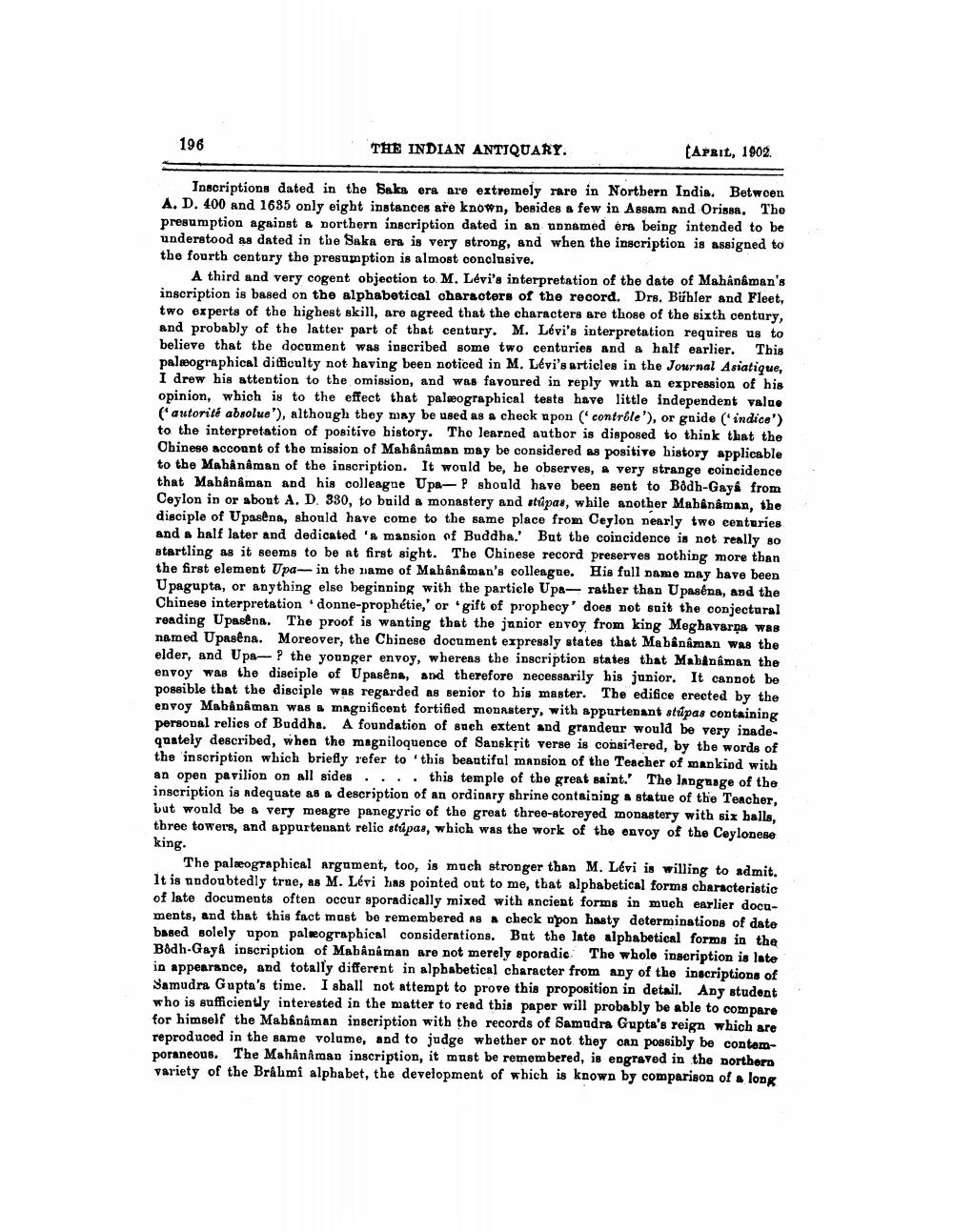________________
196
THE INDIAN ANTIQUARY.
(APRIL, 1902.
Inscriptions dated in the Saka era are extremely rare in Northern India. Between A. D. 400 and 1635 only eight instances are known, besides a few in Assam and Orissa. The presumption against a northern inscription dated in an unnamed era being intended to be understood as dated in the Saka era is very strong, and when the inscription is assigned to the fourth century the presumption is almost conclusive.
A third and very cogent objection to M. Lévi's interpretation of the date of Mahânâman's inscription is based on the alphabetical characters of the record. Drs. Bühler and Fleet, two experts of the highest skill, are agreed that the characters are those of the sixth century, and probably of the latter part of that century. M. Lévi's interpretation requires us to believe that the document was inscribed some two centuries and a half earlier. This paleographical difficulty not having been noticed in M. Lévi's articles in the Journal Asiatique, I drew his attention to the omission, and was favoured in reply with an expression of his opinion, which is to the effect that paleographical tests have little independent value (autorité absolue'), although they may be used as a check upon ('contrôle'), or guide ('indice') to the interpretation of positive history. The learned author is disposed to think that the Chinese account of the mission of Mahânâman may be considered as positive history applicable to the Mahânâman of the inscription. It would be, he observes, a very strange coincidence that Mahânâman and his colleague Upa- ? should have been sent to Bôdh-Gay from Ceylon in or about A. D. 330, to build a monastery and stúpas, while another Mahânâman, the disciple of Upasena, should have come to the same place from Ceylon nearly two centuries. and a half later and dedicated 'a mansion of Buddha.' But the coincidence is not really so startling as it seems to be at first sight. The Chinese record preserves nothing more than the first element Upa- in the name of Mahânâman's colleague. His full name may have been Upagupta, or anything else beginning with the particle Upa- rather than Upaséna, and the Chinese interpretation donne-prophétie,' or 'gift of prophecy' does not suit the conjectural reading Upasena. The proof is wanting that the junior envoy from king Meghavarna was named Upasêna. Moreover, the Chinese document expressly states that Mahânâman was the elder, and Upa- ? the younger envoy, whereas the inscription states that Mahânâman the envoy was the disciple of Upasêna, and therefore necessarily his junior. It cannot be possible that the disciple was regarded as senior to his master. The edifice erected by the envoy Mabânâman was a magnificent fortified monastery, with appurtenant stúpas containing personal relics of Buddha. A foundation of such extent and grandeur would be very inadequately described, when the magniloquence of Sanskrit verse is considered, by the words of the inscription which briefly refer to this beautiful mansion of the Teacher of mankind with an open pavilion on all sides. . . . this temple of the great saint. The language of the inscription is adequate as a description of an ordinary shrine containing a statue of the Teacher, but would be a very meagre panegyric of the great three-storeyed monastery with six halls, three towers, and appurtenant relic stúpas, which was the work of the envoy of the Ceylonese king.
The palæographical argument, too, is much stronger than M. Lévi is willing to admit. It is undoubtedly true, as M. Lévi has pointed out to me, that alphabetical forms characteristic of late documents often occur sporadically mixed with ancient forms in much earlier documents, and that this fact must be remembered as a check upon hasty determinations of date based solely upon paleographical considerations. But the late alphabetical forms in the Bodh Gaya inscription of Mahânâman are not merely sporadic The whole inscription is late in appearance, and totally different in alphabetical character from any of the inscriptions of Samudra Gupta's time. I shall not attempt to prove this proposition in detail. Any student who is sufficiently interested in the matter to read this paper will probably be able to compare for himself the Mahânâman inscription with the records of Samudra Gupta's reign which are reproduced in the same volume, and to judge whether or not they can possibly be contemporaneous. The Mahânâman inscription, it must be remembered, is engraved in the northern variety of the Brahmi alphabet, the development of which is known by comparison of a long




